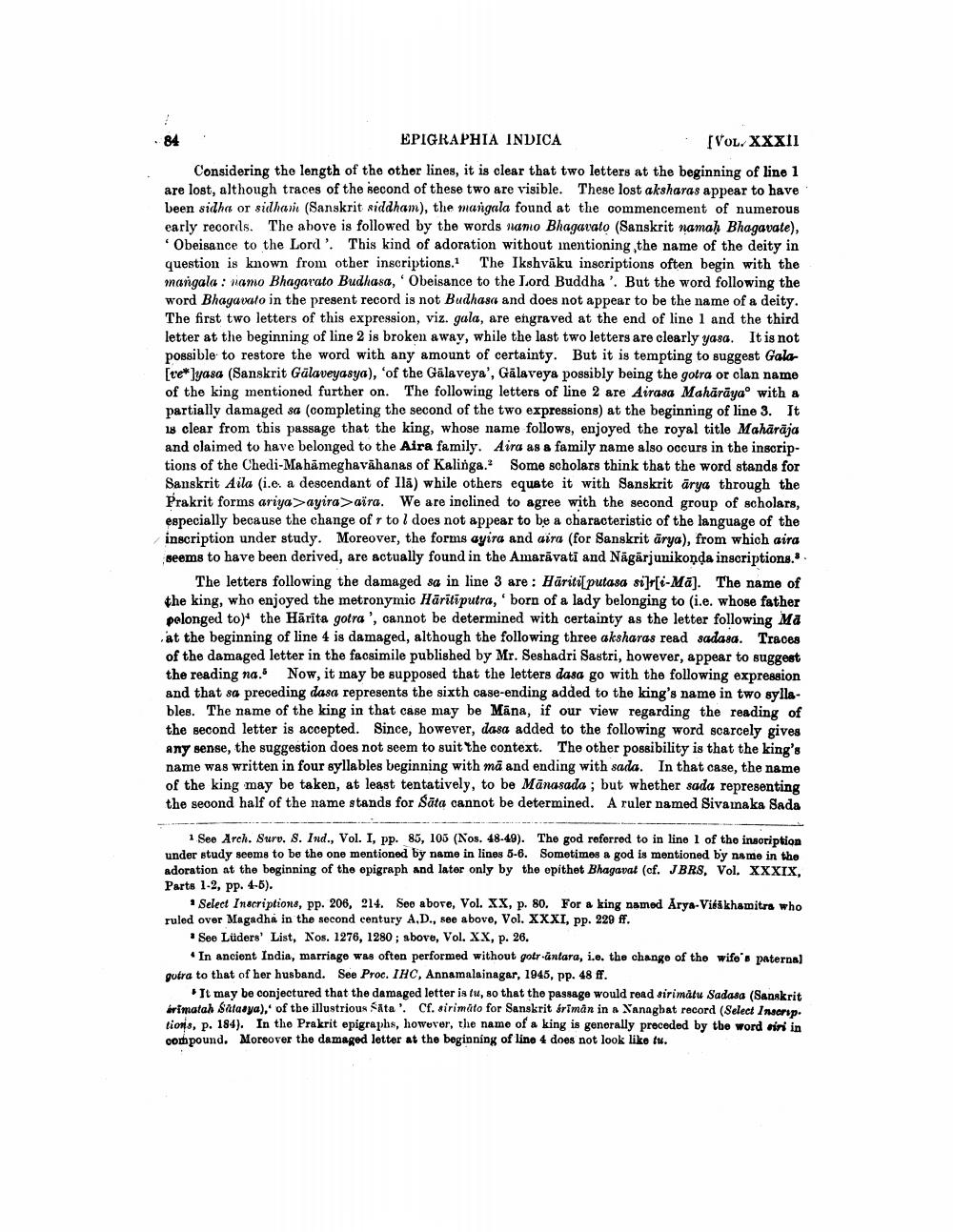________________
EPIGRAPHIA INDICA
[VOL. XXXII
Considering the length of the other lines, it is clear that two letters at the beginning of line 1 are lost, although traces of the second of these two are visible. These lost aksharas appear to have been sidha or sidham (Sanskrit siddham), the mangala found at the commencement of numerous early records. The above is followed by the words namo Bhagavato (Sanskrit namah Bhagavate), Obeisance to the Lord'. This kind of adoration without mentioning,the name of the deity in question is known from other inscriptions. The Ikshvāku inscriptions often begin with the mangala: namo Bhagavato Budhasa, Obeisance to the Lord Buddha'. But the word following the word Bhagavato in the present record is not Budhasa and does not appear to be the name of a deity. The first two letters of this expression, viz. gala, are engraved at the end of line 1 and the third letter at the beginning of line 2 is broken away, while the last two letters are clearly yasa. It is not possible to restore the word with any amount of certainty. But it is tempting to suggest Gala [velyasa (Sanskrit Galaveyasya), 'of the Galaveya', Galaveya possibly being the gotra or clan name of the king mentioned further on. The following letters of line 2 are Airasa Mahārāya with a partially damaged sa (completing the second of the two expressions) at the beginning of line 3. It is clear from this passage that the king, whose name follows, enjoyed the royal title Mahārāja and claimed to have belonged to the Aira family. Aira as a family name also occurs in the inscriptions of the Chedi-Mahameghavahanas of Kalinga. Some scholars think that the word stands for Sanskrit Aila (i.e. a descendant of Ila) while others equate it with Sanskrit äārya through the Prakrit forms ariya>ayira>aira. We are inclined to agree with the second group of scholars, especially because the change of r to l does not appear to be a characteristic of the language of the inscription under study. Moreover, the forms ayira and aira (for Sanskrit arya), from which aira seems to have been derived, are actually found in the Amaravati and Nagarjunikonda inscriptions.
84
The letters following the damaged sa in line 3 are: Hariti putasa sir[i-Ma]. The name of the king, who enjoyed the metronymic Hārītiputra, born of a lady belonging to (i.e. whose father pelonged to) the Harita gotra', cannot be determined with certainty as the letter following Ma at the beginning of line 4 is damaged, although the following three aksharas read sadasa. Traces of the damaged letter in the facsimile published by Mr. Seshadri Sastri, however, appear to suggest the reading na. Now, it may be supposed that the letters dasa go with the following expression and that sa preceding dasa represents the sixth case-ending added to the king's name in two syllables. The name of the king in that case may be Mana, if our view regarding the reading of the second letter is accepted. Since, however, dasa added to the following word scarcely gives any sense, the suggestion does not seem to suit the context. The other possibility is that the king's name was written in four syllables beginning with mã and ending with sada. In that c case, the name of the king may be taken, at least tentatively, to be Mānasada; but whether sada representing the second half of the name stands for Sata cannot be determined. A ruler named Sivamaka Sada
1. See Arch. Surv. S. Ind., Vol. I, pp. 85, 105 (Nos. 48-49). The god referred to in line 1 of the inscription under study seems to be the one mentioned by name in lines 5-6. Sometimes a god is mentioned by name in the adoration at the beginning of the epigraph and later only by the epithet Bhagavat (cf. JBRS, Vol. XXXIX, Parts 1-2, pp. 4-5).
Select Inscriptions, pp. 206, 214. See above, Vol. XX, p. 80. For a king named Arya-Visakhamitra who ruled over Magadha in the second century A.D., see above, Vol. XXXI, pp. 229 ff.
See Lüders' List, Nos. 1276, 1280; above, Vol. XX, p. 26.
In ancient India, marriage was often performed without gotr-antara, i.e. the change of the wife's paternal gotra to that of her husband. See Proc. IHC, Annamalainagar, 1945, pp. 48 ff.
It may be conjectured that the damaged letter is tu, so that the passage would read sirimatu Sadasa (Sanskrit arimatah Satasya), of the illustrious Sata. Cf. sirimato for Sanskrit śriman in a Nanaghat record (Select Inscrip. tions, p. 184). In the Prakrit epigraphs, however, the name of a king is generally preceded by the word siri in compound. Moreover the damaged letter at the beginning of line 4 does not look like tu.




